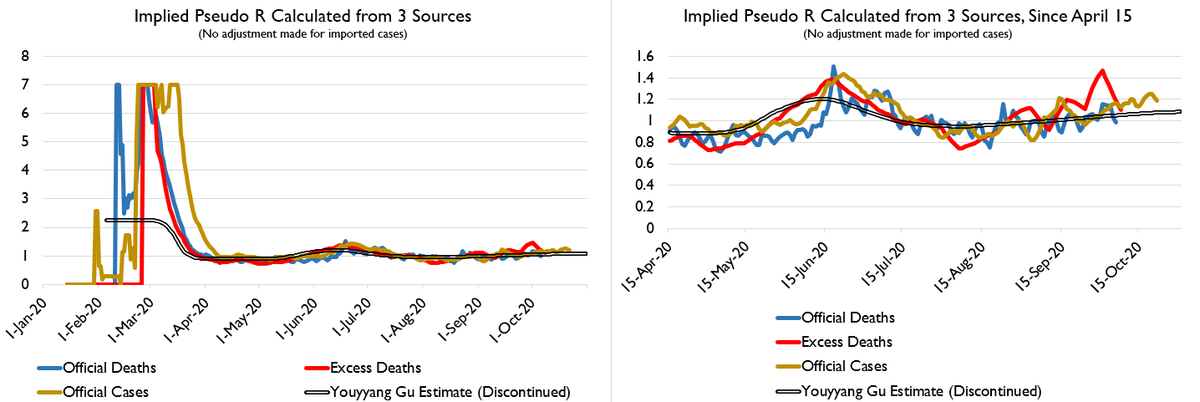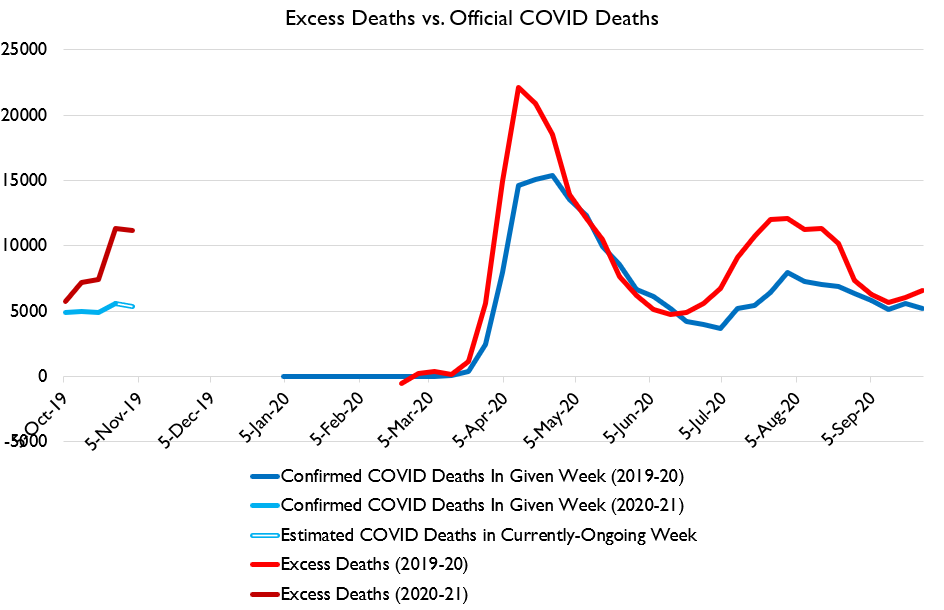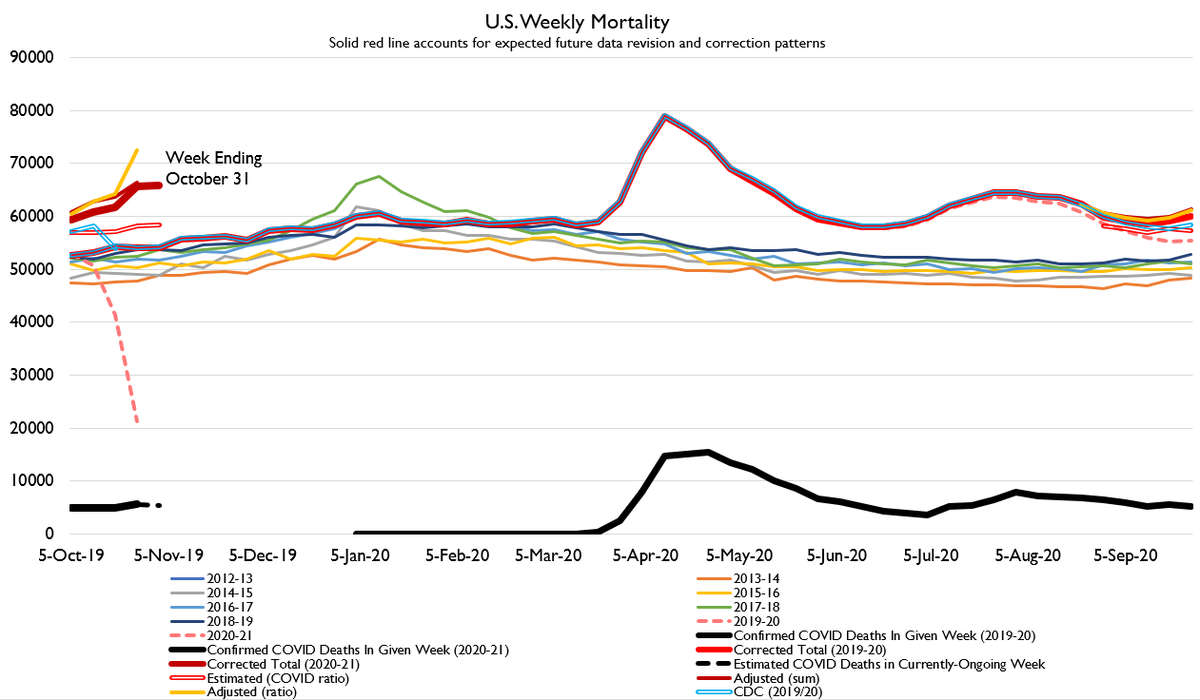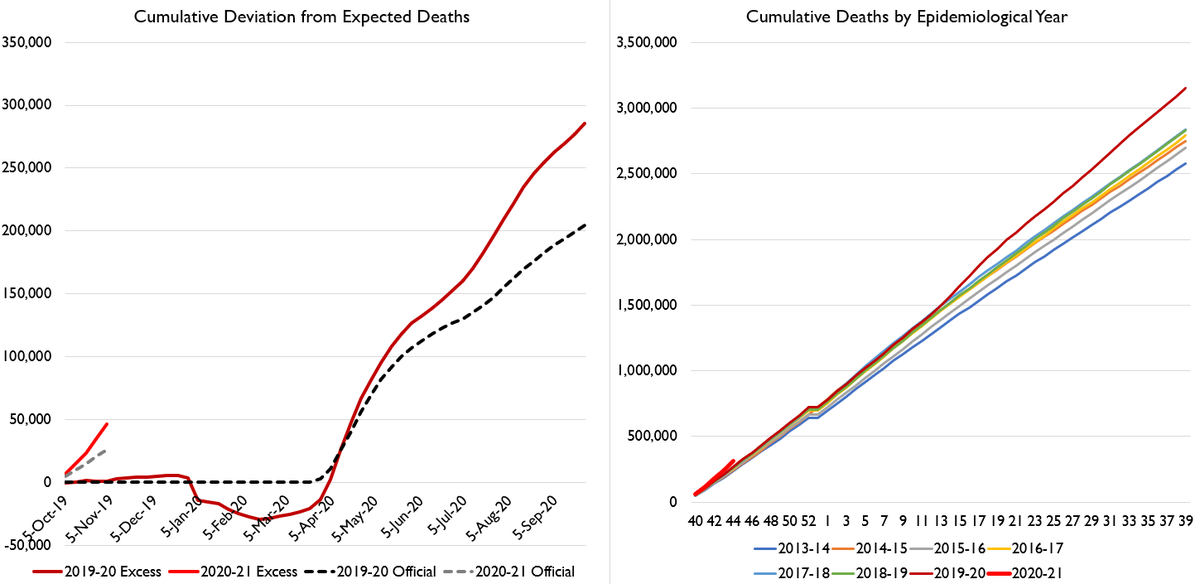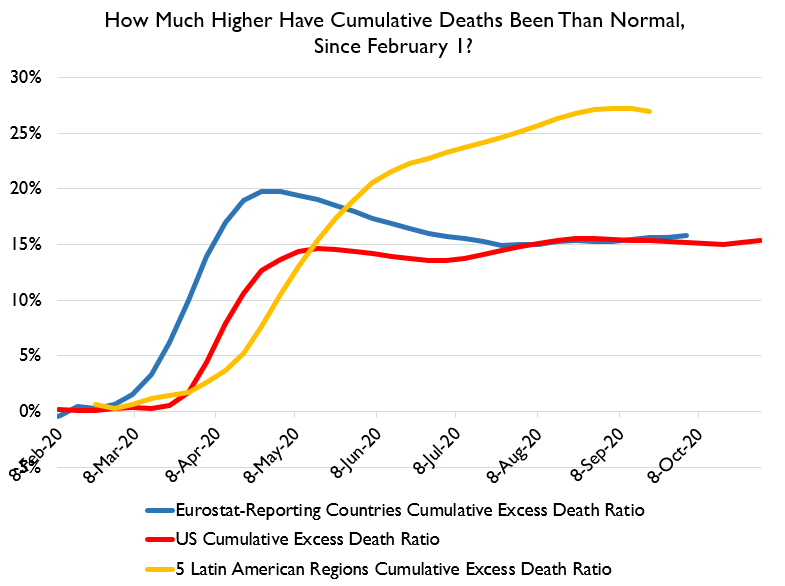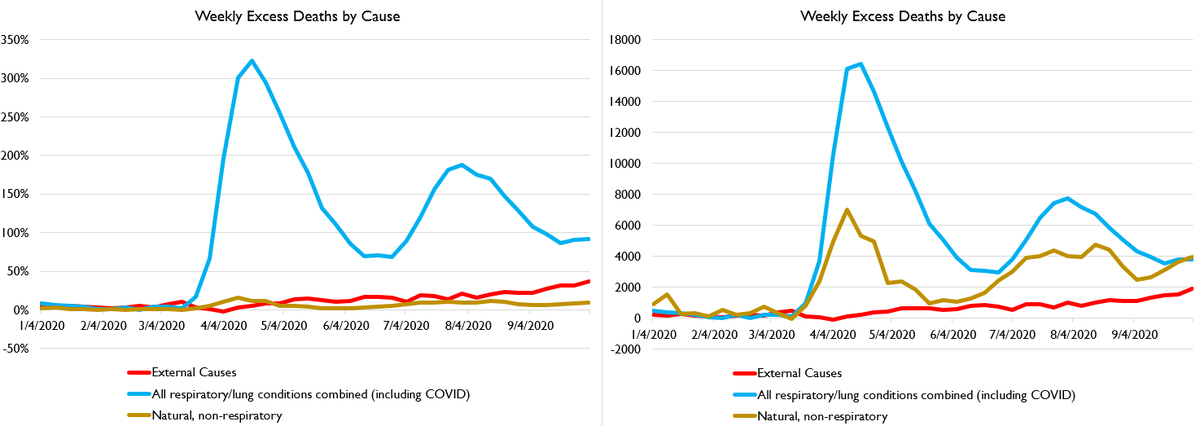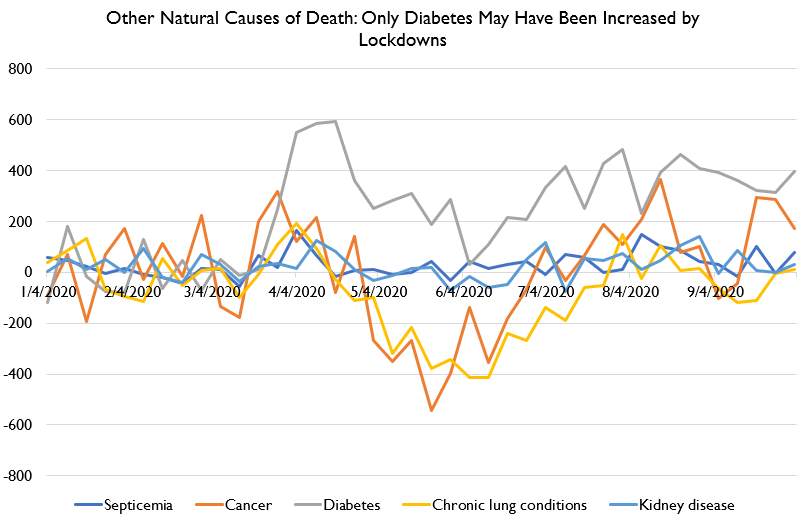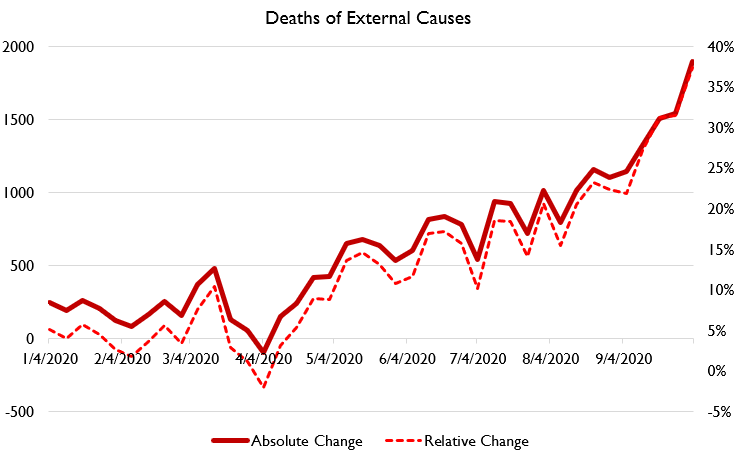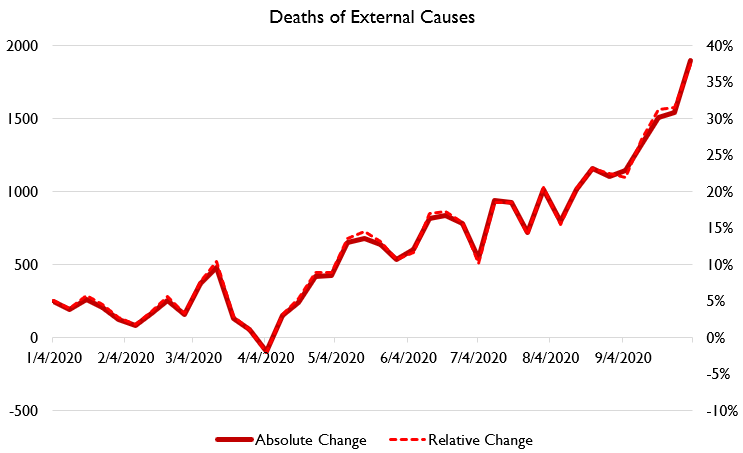It& #39;s Death Day time!
Things are bad folks. Excess deaths have cumulated up to 330,000, vs. 230,000 official COVID deaths. National R value remains above 1.
Things are bad folks. Excess deaths have cumulated up to 330,000, vs. 230,000 official COVID deaths. National R value remains above 1.
This is, how you say, not good.
It& #39;s now clear in hindsight national R values just never fell very far below 1. We just never made very much progress.
It& #39;s now clear in hindsight national R values just never fell very far below 1. We just never made very much progress.
Here& #39;s what this tells us about infections.
What stands out to me is that we are repeatedly unable to catch NEW WAVES. Seems like we continue to have a situation where death certificates only get labelled COVID after deaths have begun to rise.
What stands out to me is that we are repeatedly unable to catch NEW WAVES. Seems like we continue to have a situation where death certificates only get labelled COVID after deaths have begun to rise.
I try to account for reporting lag here, but even so it seems like hospitals don& #39;t really like to report *one* COVID death.
Here& #39;s how we compare to other area.
The U.S.& #39; excess deaths continue to be comparable to Europe& #39;s.
The U.S.& #39; excess deaths continue to be comparable to Europe& #39;s.
Also, a short reminder:
There is such a thing as a dumb question.
There is such a thing as a dumb question.
Let me briefly talk about European excess deaths.
It confuses a lot of people that European excess deaths are similar to US, despite European cumulative cases being appreciably lower. What& #39;s going on?
It confuses a lot of people that European excess deaths are similar to US, despite European cumulative cases being appreciably lower. What& #39;s going on?
One answer is simply that Europeans are untrustworthy and should generally be regarded with suspicion vs. us freedom-loving Americans who manage to keep consistent vital statistics. The European countries all report in different and idiosyncratic ways.
The same is true of COVID classification. There& #39;s simply less standardization. So you get some countries that seem to be missing a lot of deaths.
But while I love to rag on the Europeans, that& #39;s not the only thing going on.
But while I love to rag on the Europeans, that& #39;s not the only thing going on.
The issue is Europe got hit by a low-key second disaster. 2020& #39;s summer was a lot hotter than 2019& #39;s in Europe.
Now, this was true in America too. Notice the wildfires in California. 2020 was a hot summer.
But Europeans don& #39;t crank that AC like we Americans do.
Now, this was true in America too. Notice the wildfires in California. 2020 was a hot summer.
But Europeans don& #39;t crank that AC like we Americans do.
*Quite literally* as a result of the cultural difference between America and Europe on the question of AC usage, European countries tend to have WAAAAAAY more summer heat wave death spikes than the United States.
So, a BUNCH of European countries had some gnarly non-COVID death spikes in July and August.
But remember: it was NOT that Europe was hotter than the US. We both had big temperature anomalies.
It& #39;s that Europeans use less AC.
But remember: it was NOT that Europe was hotter than the US. We both had big temperature anomalies.
It& #39;s that Europeans use less AC.
Which, spoiler, kills people.
Now, USUALLY this difference works out in favor of America. Europeans lose tens of thousands of people each decade to their AC-denying-ways....
.... but guess what it turns out COVID flips that equation!
Now, USUALLY this difference works out in favor of America. Europeans lose tens of thousands of people each decade to their AC-denying-ways....
.... but guess what it turns out COVID flips that equation!
During the summer, Americans cranked that AC, closed the windows and doors, and.... died of COVID they got by circulating it around the building.
Europeans sat and sweated in outdoor cafes and a bunch of them died of heat stress, but less than of COVID in the US.
Europeans sat and sweated in outdoor cafes and a bunch of them died of heat stress, but less than of COVID in the US.
In other words, I think we SHOULD count heat deaths as COVID deaths in Europe& #39;s case. Europe experienced no summer wave *partly because* they don& #39;t use as much AC. But in America where we use AC, we got hit by COVID harder.
If a country reduced COVID deaths by executing retirees, we would definitely say that was a cost of mitigation. But more to the point, it speaks to tradeoffs: you can choose to avoid a summer wave, but you& #39;re rolling the dice on heat stroke.
Had this been the summer of 2019, which wasn& #39;t as hot, Europe would have come out WAY ahead. As it is, 2020 was a hot summer, and they only came out modestly ahead on that bet.
But now, we& #39;re both experiencing second waves. We will see who ends up worse off. But my bet is that there won& #39;t be huge differences in the long run.
Okay, pausing for a few minutes. Be back shortly and we& #39;ll talk about CAUSE OF DEATH, and how we know (yes, KNOW) that these are DEATHS OF COVID, not suicide or ODs or what have you.
Okay, let& #39;s talk cause of death.
Here& #39;s change in deaths by major cause group, 2020 vs. 2019 by week, shown in percentage and absolute terms. The last reliable week of cause data is the week ending October 4, so it doesn& #39;t show the latest spike.
Here& #39;s change in deaths by major cause group, 2020 vs. 2019 by week, shown in percentage and absolute terms. The last reliable week of cause data is the week ending October 4, so it doesn& #39;t show the latest spike.
What we can see is the increase in respiratory deaths is MASSIVE in percentage terms, and also by far the biggest increase in absolute terms.
We can also see that "non-respiratory natural causes" are extremely tightly correlated with respiratory deaths too.
We can also see that "non-respiratory natural causes" are extremely tightly correlated with respiratory deaths too.
In the latest week, non-respiratory deaths seem to be making a big comeback.
What& #39;s going on there?
Well, I can tell you it& #39;s almost entirely driven by heart attacks and strokes.
Which... we know COVID can cause! https://www.cdc.gov/coronavirus/2019-ncov/long-term-effects.html">https://www.cdc.gov/coronavir... https://www.news-medical.net/news/20200423/Coronavirus-may-cause-sudden-stroke-in-younger-patients-doctors-warn.aspx#:~:text=COVID%2D19%2C%20caused,who%20are%20feeling%20well.">https://www.news-medical.net/news/2020...
What& #39;s going on there?
Well, I can tell you it& #39;s almost entirely driven by heart attacks and strokes.
Which... we know COVID can cause! https://www.cdc.gov/coronavirus/2019-ncov/long-term-effects.html">https://www.cdc.gov/coronavir... https://www.news-medical.net/news/20200423/Coronavirus-may-cause-sudden-stroke-in-younger-patients-doctors-warn.aspx#:~:text=COVID%2D19%2C%20caused,who%20are%20feeling%20well.">https://www.news-medical.net/news/2020...
You might think what& #39;s going on is that COVID is limiting healthcare access so causing preventable deaths in these categories.
But we can look at death causes which would be uniquely sensitive to this issue, like chronic conditions such as chronic lung disease or kidney disease.
But we can look at death causes which would be uniquely sensitive to this issue, like chronic conditions such as chronic lung disease or kidney disease.
A regular reminder that if you comment on the aesthetic qualities or complexity of my graphs you& #39;re very likely to get blocked. Learn to read a complicated graph or accept you& #39;re out of your depth.
So here& #39;s those other natural causes. Several of them basically haven& #39;t changed. Cancer and lung deaths DECLINED for a while, but are now around normal.
ONLY diabetes shows what might be a lockdown effect: an immediate spike possibly due to lockdowns, and persistently high.
ONLY diabetes shows what might be a lockdown effect: an immediate spike possibly due to lockdowns, and persistently high.
So, ***it is possible*** that worsened access to diabetes treatment has led to approximately 9,000 otherwise preventable deaths, assuming NONE of the diabetes deaths are incorrectly classified COVID deaths (not true: some probably had COVID).
Meanwhile, excess deaths due to other natural causes in the same period are 270,000 (remember it& #39;s a shorter period than the all-cause I use).
So, perhaps 3% of excess deaths are these so-called lockdown deaths. MAYBE. If you assume nobody with diabetes got COVID.
So, perhaps 3% of excess deaths are these so-called lockdown deaths. MAYBE. If you assume nobody with diabetes got COVID.
So we& #39;ve ruled out the possibility of a large number of "medical access" deaths.
What about lockdowns causing suicides and drug overdoses?
What about lockdowns causing suicides and drug overdoses?
Well, before I show my data, we ACTUALLY HAVE suicide data now! Massachusetts allowed some researchers to use the full detail death certificate data and they found that suicide deaths stayed the same OR PERHAPS DECLINED during the lockdown. https://www.medrxiv.org/content/10.1101/2020.10.20.20215343v1">https://www.medrxiv.org/content/1...
Massachusetts had a very hard lockdown so this is a good test case.
There& #39;s truly no evidence yet that mitigation measures caused an increase in suicides.
But let& #39;s get back to our death data.
There& #39;s truly no evidence yet that mitigation measures caused an increase in suicides.
But let& #39;s get back to our death data.
Here& #39;s deaths of "external causes." That& #39;s homicides, suicides, drug overdoses, people falling over and dying (this is a LOT, this is how a lot of old people die), car accidents, neglect of children, terrorism, executions, etc.
Sidenote: this is a GOOD question!
Answer: a lot of people who died of COVID ALSO had e.g. cancer or lung disease. So COVID "harvested" a lot of these other deaths. So some small share of COVID deaths would have died anyways. https://twitter.com/ChrisOlin/status/1322266419329814528">https://twitter.com/ChrisOlin...
Answer: a lot of people who died of COVID ALSO had e.g. cancer or lung disease. So COVID "harvested" a lot of these other deaths. So some small share of COVID deaths would have died anyways. https://twitter.com/ChrisOlin/status/1322266419329814528">https://twitter.com/ChrisOlin...
Crudely estimating volumes, you could guess that COVID may have displaced about 7-12,000 deaths which would have happened anyways. So again, a very small share of total COVID deaths.
Okay, back to external causes deaths.
These are a SERIOUS PROBLEM. Currently, we are having almost 2,000 external causes deaths PER WEEK more than in 2019.
These are a SERIOUS PROBLEM. Currently, we are having almost 2,000 external causes deaths PER WEEK more than in 2019.
Now, reminder: we& #39;re having ***over 10,000*** likely COVID-caused excess deaths per week. So external causes deaths don& #39;t outweigh that.
But they& #39;re not nothing! They& #39;re now running almost 33% over normal!
But they& #39;re not nothing! They& #39;re now running almost 33% over normal!
We& #39;ve already shown this proooobably isn& #39;t suicides.
So, what is it?
Well, one thing we should note is excess deaths DECLINED during the opening lockdown period. That& #39;s probably car accident deaths falling as people stay home.
So, what is it?
Well, one thing we should note is excess deaths DECLINED during the opening lockdown period. That& #39;s probably car accident deaths falling as people stay home.
Oh also I realized the axis for the relative change was screwy. You all should really tell me when my graphs are hard to understand!
Here it is corrected.
Here it is corrected.
So.... what& #39;s causing this?
Well, it& #39;s probably not a big spike in traffic deaths. Across six states where 5 minutes of Googling provided me with comparative YTD traffic fatalities, I found a net 1% increase in traffic deaths. So that can& #39;t account for this big increase.
Well, it& #39;s probably not a big spike in traffic deaths. Across six states where 5 minutes of Googling provided me with comparative YTD traffic fatalities, I found a net 1% increase in traffic deaths. So that can& #39;t account for this big increase.
What about homicides?
Homicides do appear to be up. A quick Google suggests somewhere between 15% and 50% above 2019.
That could account for 30-200 extra deaths per week. A non-trivial share, but not the whole thing.
Homicides do appear to be up. A quick Google suggests somewhere between 15% and 50% above 2019.
That could account for 30-200 extra deaths per week. A non-trivial share, but not the whole thing.
We also know that deaths of children are way down, which suggests that there *probably* has not been a big rise in deaths of neglect.

 Read on Twitter
Read on Twitter